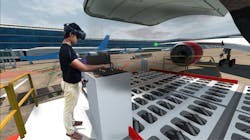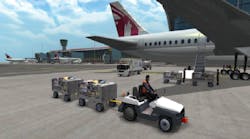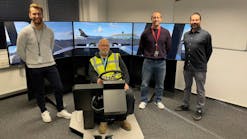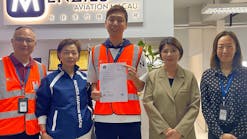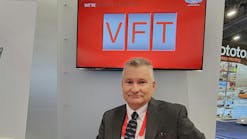Virtual Training for Real Applications
Virtual reality (VR) technology is changing the way many safety critical industries are delivering training, including aviation and aircraft ground handling.
VR, as an immersive technology, is helping those organizations that are embracing it to streamline their operations, improve capabilities and improve personnel training.
For the aviation industry, virtual reality and simulation is nothing new when it comes to pilot training, but for training on aircraft ground handling it is slowly making its in entry, according to Shantanu Gupta, founder and director of Tecknotrove Systems.
“Given the expensive nature of the aviation industry and the high cost of making mistakes, VR makes business sense for training on aircraft ground handling. There are many documents made by several bodies, including IATA and ICAO, on the best practices and training procedures for maintaining safety on ground while handling aircraft,” he says. “But all of this data is analog, i.e., it is stored in books and presentations at best. We use VR to convert the training manual from analog to digital to make it more usable. VR is becoming a great asset for aviation companies to provide better service and train their staff in a more accurate way”.
How Common is VR?
KLM Royal Dutch Airlines has two VR courses available for aircraft ground handling at the moment: one is for attaching a jetway bridge to the aircraft, the other is for aircraft pushback.
“When new personnel arrive who are responsible for these two specific tasks, they are trained by using VR. We supply the VR courses to colleges as well, where this training is delivered every day,” KLM officials say.
VR training is being slowly but surely recognized as a new cost-efficient method for training personnel.
“It is not very common yet, but the adaptation process has already started in many big companies, leading ground handlers, in general, as it was expected. Of course, for any big handling company with hundreds of stations spread across the globe, the investments are most likely to be returned very soon because of the easy scalability of such training solutions and it’s digital/virtual nature,” says Grigory Rodionov, founder and chief executive officer of AVIAR.
“VR training has been evolving rapidly in different sectors around the world. According to IATA, VR can reduce training duration by 25 percent while simultaneously improving the knowledge retention of your trainees by four times,” says Cisse Abdoulaye, chief operations officer of ground handling and cargo at National Aviation Services (NAS). “While it has been established as a great tool for training, it has been slow on the uptake in the aviation sector, and ground handling in particular. This has been mainly due to two reasons – firstly the costs involved and secondly the scarce availability of such courses.”
According to Rodionov, however, the future of VR training seems to look bright even though the growth was slowed down by the pandemic and its effect on the whole air transport industry.
“Cutting the costs is still in the main priorities of top managers and it is understandably not easy for them to think of any innovations under that pressure. We expect that 2022 will be better than last year, and 2023-2024 hopefully will bring us a huge demand for VR training pushed by the full aviation sector recovery,” he says.
Advantages and Disadvantages of VR Training
According to Abdoulaye, VR training has several advantages over traditional training that include comfort, safety, adaptability, convenience, interest and retention.
“The ramp environment can be very noisy, making it difficult to concentrate. VR provides a more suitable environment to focus on the training and get the hands-on experience required,” he says. “Working in a secure environment with no exposure to the ramp side threats makes the process safer and more secure while avoiding any security issues. Using VR means one does not need to utilize real company assets, so there is no chance of damage or inappropriate use of expensive equipment.”
Systems can be used multiple times, so there are little technical issues to worry about.
“For instance, if a real aircraft is involved, one cannot start and stop it multiple times. With VR, one can also replicate or have different scenarios in a variety of conditions thereby making VR a more convenient training tool,” says Abdoulaye. “In addition, VR allows repetition in a controlled environment, which generates more interest in the trainee and allows more information retention.”
Gupta observes that theoretical training without interactivity does not keep the trainees engaged and thus leads to low retention of knowledge.
“In addition, there are several constraints with classroom training like inability to train on weather conditions, emergency situations, low visibility operations. Whereas live training is risky, expensive and less practical because of it dependency on availability of an aircraft and access to airside VR training complements theoretical training with practical experience,” he says. “It helps trainees to be better engaged in the process as they are immersed in a realistic training environment. This, in turn, improves retention and learning. One can create multiple scenarios in a virtually realistic environment that allows trainees to familiarize themselves with the airside environment, different aircraft types, as well as learn to operate in varying levels of visibility during day and night and even practice in emergency situations that are not possible to create in real life conditions.”
VR training is not to replace classwork.
“The main purpose of VR is to add a new dimension to conventional training processes by bringing the realistic virtual airport into the classroom and let the students start developing their practical skills much earlier, getting an in-depth understanding of their future workplace and all the processes and the equipment nuances,” says Rodionov.
Among the pros of VR training versus on-the-job training is the fact that VR training is much less expensive, according to Rodionov.
“Just because it is all virtual. So, one can get rid of any associated costs like using real aircraft and equipment, parking stands, fuel, transportation, accommodation, insurances, supervisors, repairs and so on,” he says. “VR training does not require any special buildings, prepared and equipped areas, mock-up zones. Any classroom with 3m-by-3m empty space is fine. Unlike during conventional practice at the real ramp or mock-up area one is not limited by the exact type of equipment available.”
VR training, however, also bears some limitations compared to traditional training. Aside from the upfront cost of implementing VR tools, one disadvantage is the chance of cyber sickness or comfort issues with extended wear of the goggles, observes Abdoulaye.
“A minor human nature aspect could also be that trainees know that they are in simulations and errors will not cause any real damage. This may make them slightly less attentive or focused, but it is a very small probability,” he says. “VR training also isolates trainees from wider social interaction with peers, which has its own cons.”
Rodionov observes that since training is all virtual, all objects in VR are weightless.
“So, for instance, one can move a 200 kg tow-bar almost effortlessly. In most cases, we simulate the weight of the virtual objects via inertia and also, if the object is heavier than 30 kg, we block the free movement of it. For example, it just cannot be carried by hand, only by pushing or pulling along the surface. But many people do not see it as a huge problem, which affects the training goals,” he says.
“In some cases, it takes time, from 3 to 15 minutes for some people to get used to controls and user movement in VR,” Rodionov continues. “It mostly happens to mature audiences. We see that younger people are completely fine with it. The comfort of VR headsets is in constant improvement, so every new generation is lighter, thinner and has a better image quality. But the best existing devices in terms of graphics quality and the realism still require a connection to a PC. So, this wire attachment is sometimes annoying. But we believe that it will be gone in two to three years.”
Types of Training
Abdoulaye believes that in ground handling, multiple courses can be delivered effectively through VR, especially those involving safety and equipment, customer service, etc.
“This is mainly because trainees can get significant hands-on experience without the hesitation or nervousness of working on real equipment,” he says. “They can practice more in different conditions and scenarios, giving them more experience during training and finally protecting equipment since its expensive to buy and maintain.”
“We cannot think of any ground handling training that could not be done in VR. But the most suitable involve expensive, hazardous and unsustainable environments,” KLM officials say.
From AVIAR’s experience, VR is suited for all underwing operations, but especially for those where operators are in close contact with the aircraft.
“Actually, the aircraft is the most expensive part of the turnaround process, and every minute an aircraft spends on the ground is strictly scheduled, so usually it is not possible to have the real aircraft just for training purposes. And here is where VR can really help,” says Rodionov. “In VR, one can practice with almost identical virtual aircraft as long as it is needed. Examples of such scenarios include aircraft marshalling, post arrival checks, chocks and cones placement, GSE connection/disconnection, passenger bridge operations, aircraft cargo doors operations, aircraft water servicing, aircraft toilet servicing, aircraft refueling, pre-departure checks, pushback.”
Raising Safety Awareness
Indeed, VR training can be used to raise safety awareness in aircraft ground handling. VR can be utilized to develop a culture and awareness of safety by creating scenarios which allows for significant practice and experience, according to Abdoulaye.
“By ‘living’ an emergency situation in VR and seeing and understanding the impact of one’s decisions, one becomes even more aware of safety procedures,” KLM officials say.
Most aircraft ground handling incidents occur when the aircraft is parked and when there is a close contact between the aircraft and ground support equipment, says Gupta.
“An aircraft that breaks down just before take-off is an expensive problem that can costs millions. VR training solutions can help in improving safety awareness during aircraft ground handling for new recruits as well as the experienced staff,” he says.
During ground operations, several pieces of equipment like passenger boarding bridges, baggage trucks and carts, pushback tractors and tow-bars, cargo loaders, refueling trucks and cleaning trucks come in close contact with the aircraft posing great risk to the airplane and the property, observes Gupta.
“Safe operations during ground handling is a shared responsibility between operators and airports. Thus, group training in VR of drivers, pushback operators, wing walkers, ATC, security staff, rescue and firefighting, airport authorities can really help in improving safety awareness. VR training allows group training of multiple players operating in the same environment.”
VR is the only type of media which lets the users find themselves inside the scene.
“It is completely different from pictures or videos. For instance, one can literally walk around the aircraft and along the ramp with all the equipment and staff and find the problems. One can visualize any hazardous situation, as close to reality as possible, and can let students see it from the first person’s perspective,” he says. “Also, in some scenarios we recreate the aftermath of some major mistakes so the students can see how bad it could turn in case of error. And the efficiency of such training is undoubtedly high.”
VR training will not likely completely replace on-the-job training in the near future.
“However, VR will definitely help companies to improve the training process by filling the knowledge and skill gaps between the classroom and the real work. Better trained staff means safer and better operations and as a result operational cost reduction,” he concludes.
